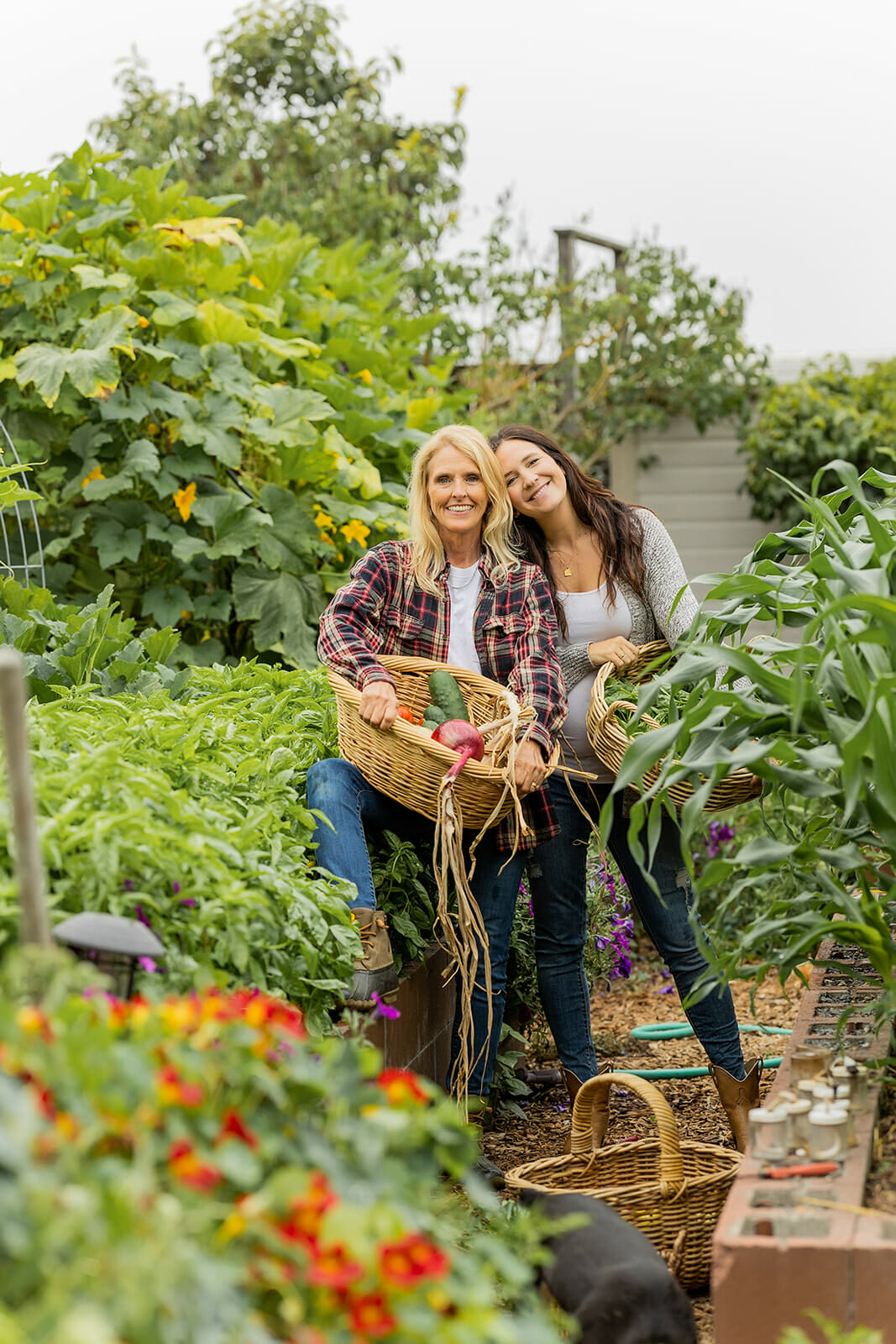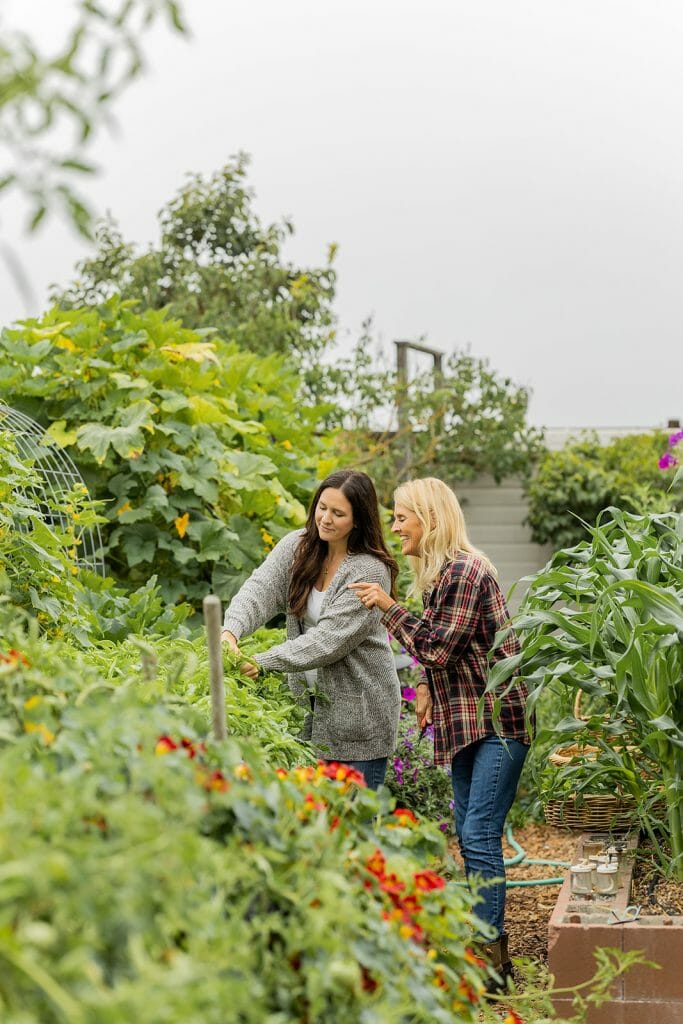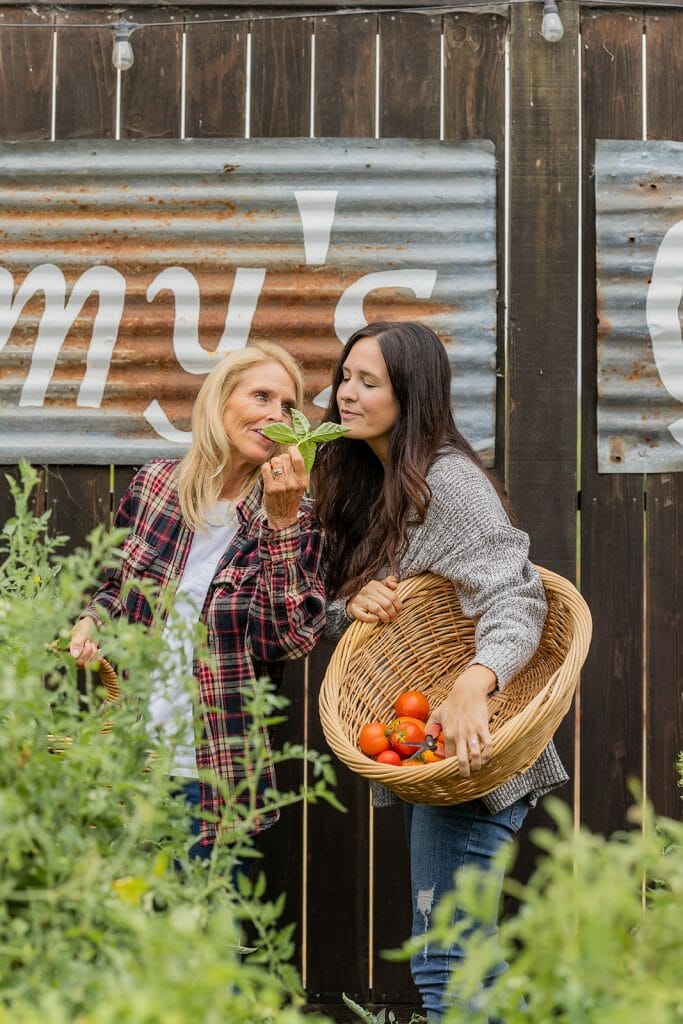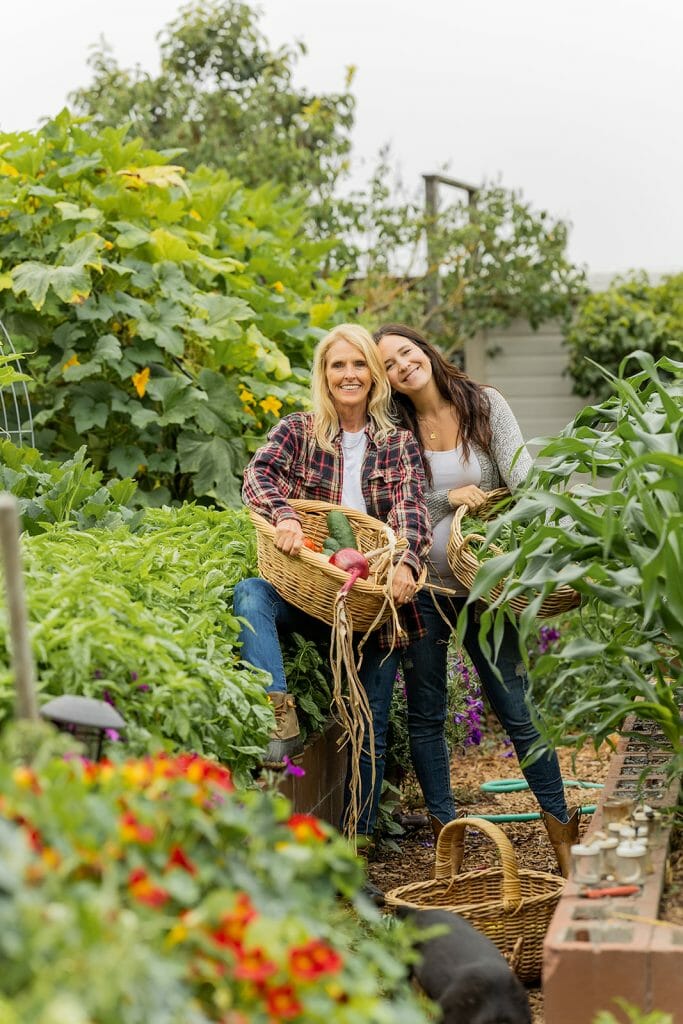
Expert Gardening Advice from My Godmother, Pamela Martinelli
I grew up in Sonoma County, California (“Nor Cal”) where world-class pinot noir and chardonnay are grown and wild mustard shines between the rows of those grapevines and redwoods line the drive to the house I grew up in. Luckily for me, the people back home are of a certain breed. I had no idea how much it all influenced me until my thirties, and I longed for the character, grit, and humor of my hometown neighbors.
Pam Martinelli, “Aunty Pammy”, is my Godmother, brought into my life at six weeks old as a dear friend of my parents. She was always a steady force in my life and even then had kept a garden. My dad used to call her, “Pambo” (like Rambo) and the rest of us called her Mini Martha because she hunts, fishes, cans, gardens, sews, builds her own barn doors and whatetver else, and throws a hell of a party. She’s wildly capable, energetic, sensible, and generous.
Early on my “I want be just like Aunty Pammy” kicked in. She really set the example for how I wanted to show up in the world and even hundreds of miles away in an entirely different setting, her influence seeped in and I find myself gardening and cooking just like she exemplified. It was really her way of being and how she lived each day that made an impact.
Pam never really “taught” me how to garden, because I truly had no interest until I had moved away. But when I did, she’d call and give advice, always gently nudging me if she noticed something a little off. I had wanted to come visit just to soak up time with her, but over the last seven years have been doing all the get married and have kids things that tend to take a hold on your time.

This visit landed smack in the middle of back-to-school, my third pregnancy, and harvest season for the family’s winery, but I was determined to make it happen. It was the first time that we got to garden side-by-side and I could ask ALL THE QUESTIONS as they came up in real-time. It was a basic interrogation by me, which led to just so much good storytelling and cooking and sharing of the secrets that actually work.
After two years now as a gardening influencer (can you feel me cringe as I say the “I” word?), I had come to feel some pressure to follow trends, and do “the right thing” like follow a no-till method with my garden beds. There is nothing wrong with that, except that it’s not been serving me personally. I’ll explain in more detail, but want to share the highlights of what I learned while sharing time with Aunty Pammy.
On a related, but separate note, I have to say something:
There is NOTHING that compares to spending in-person, real-life time with people whom you care about, who know you deep down to your roots. I was able to attend a dinner with people I hadn’t seen in a decade, who knew me as I grew up from kindergarten to high school diploma. Sharing space and smiles and stories is everything. The actual hugs and real moments are what remind us that life exists outside of the glowing rectangular screen that we hold in front of our faces.
I knew that I needed this trip for my heart and soul, I needed a reminder of the truth of life beyond the alternate universe that is curated and censored on Instagram. If you get the opportunity – no no, if you can create the opportunity to go visit someone you admire, DO IT.

Okay, now back to Aunty Pammy’s Lessons:
Soil
Each time I’ve gotten soil whether bulk or bagged, I’ve gotten a call from Aunty Pammy who’s seen the wood chips. Gah, there is so much filler in soil that you buy. She explained to me her process for amending beds, knowing that after a few seasons my soil will get to a better place. In the meantime, she wanted to encourage me to do a couple of things in my own garden that I had been avoiding because of the “soil web” I didn’t want to disrupt.
Here’s the thing – raised beds are different than in-ground. Home gardens are different than farms. We have to add nutrients to our beds, and there are all-natural additives (fertilizers) and amendments. So, amending we must do or our soil will be so depleted that it can’t nourish the plants at all.
To each his own, but it was time for me to try a new approach.
Amending
To amend her beds, Pam pulls out her plants when they are done before winter sets in. In the spring she adds about 4” – 6” of compost – mixing it all into the existing soil. Before planting she and adds kelp meal, gypsum, and rabbit poop, mixing it all into the existing soil – not entirely turned in, but mixed into the top layer. She then adds about 4” – 6” of compost. And then, at the time of planting, top dresses her bed with fertilizer – an 8-5-0.5 NPK which ends up getting mixed in as she plants, and watered in over time. Her fertilizer is a slow-release that is pelleted.
Unlike me, she does not add worms or worm castings, and never again fertilizes after that first application. Needless to say, after seeing her garden compared to mine, I’ll be adjusting my approach.
Pulling Plants
When it comes to turning over beds, I had been cutting my plants just below the soil, not pulling them out. This is a no-till method. I love this idea. But, it can allow for bugs to lay eggs in the soil, and then they never leave the soil, tormenting you and destroying your crops. She recommended I pull all my plants that were done producing and let the soil release any pests trying to overwinter or lay eggs.
This is one of those pieces of advice that is about experience and not trends. I’ll try it and report back, but have a feeling that Pam is on to something.
Pests
There are three pests that we most talked about: aphids, cucumber beetles, and rats. From day one, Pam has warned me that rats are an urban gardener’s worse adversary. The reality is that they’re everywhere, and we just rarely see them… until we start gardening. She has a rat terrier (I’m having a hard time convincing my husband of a second dog), but she also makes a natural deterrent that I have also been making since my first year gardening, following Pam’s advice and reaping the benefits.
They’re peppermint oil diffusers. She places them throughout the garden and they work wonders. It’s simply a glass jar and lid with ¼ of it filled with peppermint oil (bought in bulk off Amazon) and a wick dipped into the oil via a slit in the lid that she cuts. That is it.
As for aphids, she gets them mostly on her kale (her giant, forest of 4’ tall kale), but since the plants are strong (because of good soil), they always rebound. So, she leaves the aphids each year and they eventually go away.
Lastly, cucumber beetles were a big problem one year for Pam and she did research on it. Nematodes were the answer and they worked wonders. They have to be refrigerated, and when you apply them you must speak loving to them, encouraging them to kill the beetle larvae. Do we need to talk to the nematodes? Yes. This is what I’ve been told by the queen herself, so you better listen.
I have used nematodes as well to help with grubs and can attest to their effectiveness as well. My nematodes liked more of a song and dance approach, but that’s because they’re from suburbia and high maintenance like that :).

Planning the Garden
I got a hold of Pam’s garden plans, which she has a record of in a casual green folder on her desk. They date back to 2001, first hand drawn and then graduating to a simple color-coded excel sheet. She follows the same method of hand-drawing the garden into a template she made in excel, and then once she orders everything, places it into excel and color codes it for easy reference. It’s really quite simple and does prove to be more effective than the software I’ve been using. Oh, how I love to overcomplicate things.
Pam tracks the variety she likes because her #1 rule of gardening is: to grow what you eat. Her favorite tomatoes are Cherokee purple and pineapple, she grows lemon cucumber each year, a ton of gourds (because they’re so fun), and swears that you just can’t beat purple wave petunias.
She also grows massive onions that she gets as starts from Dixondale farms, carefully following their advice on day length and planting.
Crop rotation is Pam’s second biggest tip, followed closely by paying attention to what doesn’t like to be grown together (the opposite of companion planting) as plants with different needs will lead to a lackluster garden. She’s right about that too.
What Pam does to ensure this all is that she plans her garden at one time for the entire year. So, she knows after she pulls up onions, in go fast-growing corn. The next year, tomatoes get a new bed, and so on and so forth. I had been planning each season separately, which can lead to a more complicated approach and less efficient use of my garden space.
Harvesting
While I didn’t need too much of a reminder on this, Pam and I talked a lot about vine-ripening. Tomatoes can be counter-ripened as can peaches, but they’re much better on the vine until ready. Basil is something you must harvest properly, being sure to cut just above the last pair of leaves that shows new growth coming in.
Years ago – probably twelve years ago – I visited Pam to go camping at a nearby lake. I got there and just before leaving for our drive up to camp, Pam sent me out into the garden with a quick tutorial on how to properly harvest the basil, telling me to get absolutely everything I can. I think I spent 45 minutes out there doing just that as she always has half a bed at least full of basil that just goes hog wild.
Meanwhile, Pam was packing a generator, parmesan, garlic, salt, and pine nuts so that we could blend everything in her Cuisinart and make pesto. I completely understand now that if we hadn’t harvested it, the basil would have gone to flower and we would have missed our window.
The story cracks me up because who else is lugging a generator and food processor around on their camping trip to make pesto to vacuum seal and freeze? We are, that’s who.
This is the work of a legacy, and you better believe I’ll be found following suit someday if need be.
Rabbit Poop
Aunt Pammy has been in agriculture for years and was raised to bring up her own meat and to truly use every single part of the animal. Even if there are scraps from butchering or processing, she’s making it into stock or dog food. Nothing gets wasted and that is the honor of hunting and raising your own animals for meat – you treat it as the special and precious commodity that it is. You honor it and waste nothing. You protect your animals from other predators, from unnecessary harm, and you do lovingly care for them.
Pam’s daughter got rabbits for 4H and then FFA to raise for meat, and they ended up loving the process. She now keeps rabbit, as it is incredibly nutritious and you get a bonus byproduct – poop! Rabbit poop is one of the only non-hot animal poops, so you don’t have to age it to use it in the soil. Chicken manure for example needs to be aged and cooled for about two years before it’s safe to not burn your plants.
She showed me how she sets the cages up so that the poop drops down and can easily be scooped up and sent straight to the garden either as a top dressing or mixed in. Because of the natural pelleting and drying, it acts like a slow-release fertilizer, adding to the magic of her garden.
Preserving and Prep
This is a bit of a digression, but once you have the bounty, what do you do with it? Pam is gifted when it comes to her preservation via canning (both methods), freezing, and storing. She batch cooks a sauce base that can be used for marinara, salsa, enchilada sauce, pickles onions, cucumbers, and jalapenos, makes jams and jellies, and pesto and all the good stuff. She makes what she uses most of, perfecting recipes along the way to fill a pantry (and cellar and many freezers) with staples that carry her through each year.
Pam also talked a lot about how she batch cooks once a week to set them up for meals that will give leftovers, as well as meals that can then be frozen for later or to share. If you commit an afternoon to this you have weeks of ease and convenience.
There were two meals that I really loved while visiting – the first was so simple. Leftover chicken thighs with lemon cucumbers that were salted with a tiny bit of mayonnaise. I mixed it all together and had that for lunch. Then for my breakfast send-off, she sauteed some tomatoes and cooked over-easy eggs with them -salt and peppering it all, and that’s it!
Simple, flavorful, from the garden.
Community
The final element that I really admire about Aunty Pammy’s garden is the element of community. And this is what I remember from my childhood. Her kitchen was always full of people and laughter. You never leave empty-handed – she’s sent me home many a time with frozen meat or sauce in my carry-on! Neighbors drop jars off for canning season, or hang peaches on the door handle to share their bounty, much like Pam has done for them, making meals for families in crisis or having a local chef come to get some basil for a harvest dinner.
She taught canning classes for years to support local fundraisers and has girlfriends come over for wine and pasta sauce making.
She makes gardening, preserving, and processing so approachable – never to be found with a “secret recipe”, but instead a willingness to share and teach.
While the visit was just over 24 hours, we packed in so much quality. I had to stretch my legs every hour or so to keep up physically with Pam’s pace, reminding me of just how good it feels to lean in to what you love. In addition to my interrogation and our harvesting and sauce making – that was my number one recipe needed – we also made sides for a 15-person dinner that night. We whipped up a Caprese salad, tartar sauce for some of the 200 lbs of salmon she recently procured and filleted, and a port cake. We went to get her weekly raw milk (she co-ops a milk cow), prepped a chef for harvesting from the garden for the next evening’s soiree, and of course bagged her special fertilizer into vacuum-seeled pouches for me to take home in my carry-on!
I didn’t want to miss a thing, though we had to table the pesto and tomato pie making which were on my list, though just couldn’t be squeezed in – Pam was up for it, but I lost steam!
If there’s one final note, many people via Instagram were asking as I captured the weekend who taught Aunty Pammy everything, and what her backstory was. While that’s not my story to tell, it was all before you YouTubed and Instagrammed everything. She had family that taught and inspired her, with her eagerness to learn as she gained interest. Pam has tons of fun cookbooks and is diligent about researching new skills and approaches. She is not a corner-cutter.
She also told me about her first flower boxes and how she unknowingly planted flowers from the nursery, doing nothing to the soil, watching in disappointment as everything didn’t grow. From there she kept trying, and learned about soil health, organic fertilizing, what does well in her climate, and so on.
She reminded me that she still has crops that fail, and lessons to learn herself, all a part of the fun.
Stay in touch as I beg Aunty Pammy to come to visit me in Spring and help with the garden (and new baby), and as we plot to teach more women about these wonderful and timeless skills. I can’t stop gushing about my visit and hope this has dully inspired you to share your knowledge, hone your skills, and invest time in the people you love, as that is what truly matters. Nothing more.
Happy gardening, my friends!
